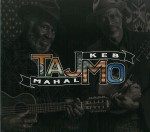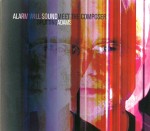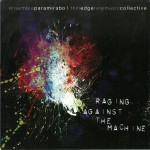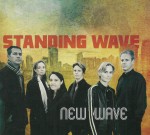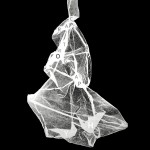Editor's Corner - September 2017
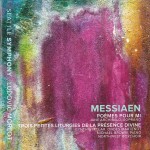 Canadian soprano Jane Archibald’s international career continues to flourish with recent and upcoming performances in leading roles at the Met, Opéra national de Paris, La Scala, Royal Opera House Covent Garden, and opera houses in Düsseldorf, Munich, Zürich, Santa Fe and Madrid, plus a tour with the English Concert as Armida in Handel’s Rinaldo. Here at home, Archibald is the Canadian Opera Company’s Artist in Residence for the coming season, featured in Mozart’s The Abduction from the Seraglio, Stravinsky’s The Nightingale and Other Short Fables and as Zdenka in the COC’s premiere production of Strauss’ Arabella, which opens at the Four Seasons Centre on October 5.
Canadian soprano Jane Archibald’s international career continues to flourish with recent and upcoming performances in leading roles at the Met, Opéra national de Paris, La Scala, Royal Opera House Covent Garden, and opera houses in Düsseldorf, Munich, Zürich, Santa Fe and Madrid, plus a tour with the English Concert as Armida in Handel’s Rinaldo. Here at home, Archibald is the Canadian Opera Company’s Artist in Residence for the coming season, featured in Mozart’s The Abduction from the Seraglio, Stravinsky’s The Nightingale and Other Short Fables and as Zdenka in the COC’s premiere production of Strauss’ Arabella, which opens at the Four Seasons Centre on October 5.
Primarily known for her interest in the Baroque and classical eras – her discography includes music of Charpentier, Vivaldi, Haydn and Mozart – Archibald has also been known to venture bravely into the 20th century, as witnessed by the latest release from the Seattle Symphony. Continuing its own commitment to the music of our time, and in particular modern French repertoire, following three recordings of works by Henri Dutilleux, Ludovic Morlot leads the orchestra in seminal pieces by Olivier Messiaen (SSM1016 seattlesymphony.org). A relatively early work, Poèmes pour Mi, dates from 1936. Originally written for soprano and piano, the work appeared in an orchestral version the following year and was Messiaen’s first vocal work to be orchestrated. It was dedicated to his first wife, violinist Claire Delbos; “Mi” (as in “do, re, mi”), corresponding to the highest string, E, on the violin, was his nickname for her. As with all of his vocal settings, the texts are by the composer. Archibald’s clear, pure soprano voice is particularly well suited to this deeply personal work that explores the spiritual aspects of marriage. It is rarely heard in its orchestral version, and in fact this recording is a first for my own extensive Messiaen collection.
The song cycle is nicely complemented by another pivotal vocal work, Trois Petites Liturgies de la Présence Divine from 1944, following Messiaen’s release from a German prison camp in Silesia where he composed the Quatuor pour la fin du temps. The Liturgies were written for high male voices (the Northwest Boychoir in this recording) and an orchestra featuring Messiaen’s signature sounds of obbligato ondes Martenot and piano, played here by Cynthia Millar and Michael Brown respectively. All involved perform with distinction under Morlot’s direction in this significant addition to both the orchestra’s and Messiaen’s discography.
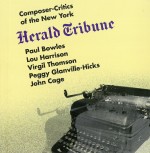 Having just mentioned Messiaen’s Quatuor, I will use it to segué to the next disc that caught my attention over the summer, Composer-Critics of the New York Herald Tribune (Other Minds OM 1024-2
Having just mentioned Messiaen’s Quatuor, I will use it to segué to the next disc that caught my attention over the summer, Composer-Critics of the New York Herald Tribune (Other Minds OM 1024-2
otherminds.org). The outer Chorale movements of Lou Harrison’s Suite for Cello and Harp (1949) put me in mind of the Louange à l’Éternité de Jésus for solo cello and piano in Messiaen’s iconic work, not in a derivative sense, but rather in their meditative sensibility. Harrison (1917-2003) is one of five composers featured on this intriguing disc, which includes program notes and an extensive essay by another pioneering figure of American art music, Charles Amirkhanian, and two articles by the Herald Tribune’s chief critic Virgil Thomson. The more-than-50-page booklet is an important artifact in its own right, not only giving context to the music, but painting an intriguing picture of a time quite unlike our own, when art music was treated seriously, and prominently, by mainstream media.
Thomson’s own witty Capital Capitals, on a text by the inimitable Gertrude Stein, is included along with works by novelist/composer Paul Bowles, Australian-born Peggy Glanville-Hicks and a man who arguably had the biggest influence on our basic understanding of the very nature of what constitutes music, John Cage. Thomson’s 1927 setting of the tongue-twisting text, which riffs on CAPITAL LETTERS and Capital Cities, is scored for four alternating male voices and piano. It is the earliest work presented, with Glanville-Hicks’ craggy Sonata for Piano and Percussion (1951-52) with its, perhaps inevitable, echoes of Bartók, the most recent. Bowles is represented by the tongue-in-cheek Music for a Farce (1938) for clarinet, trumpet, percussion and piano, and Cage by the quietly haunting, and now iconic, String Quartet in Four Parts (1949-50) performed by the New Music String Quartet.
Upon first listening I did not realize the recordings were historic, as the sound is convincingly pristine. But they are all monophonic and were originally issued by Columbia Records between 1953 and 1955 on the Modern American Music Series. Reproduced under license from Sony, this Other Minds release is a welcome addition to my understanding of mid-century American music and culture. The booklet also includes the strikingly modern cover art from the four original LPs.
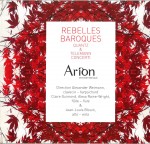 Although recorded in 2014, Rebelles Baroques (EMCCD7777, early-music.com) is the most recent recording of Montreal’s Arion Orchestre Baroque to come my way. Featuring music of Quantz and Telemann, it focuses on two composers who developed and perfected the goûts réunis style of the early-to-mid 18th century, integrating French and Italian approaches into German music. While simply referred to as rebels in the disc’s title, the booklet essay calls Georg Philipp Telemann and Johann Joachim (J.J.) Quantz “Delightful Rebels” (“Charmants Rebelles” in Jacques-André Houle’s original French) which seems to incorporate both the elegance of the music and the fact that Quantz and Telemann had to fight against family prejudices to follow their chosen musical paths. Telemann was expected to become a clergyman like his father, while Quantz’s family trade was blacksmithing. Both overcame the odds to follow their own dreams and to our benefit the rest, as they say, is history.
Although recorded in 2014, Rebelles Baroques (EMCCD7777, early-music.com) is the most recent recording of Montreal’s Arion Orchestre Baroque to come my way. Featuring music of Quantz and Telemann, it focuses on two composers who developed and perfected the goûts réunis style of the early-to-mid 18th century, integrating French and Italian approaches into German music. While simply referred to as rebels in the disc’s title, the booklet essay calls Georg Philipp Telemann and Johann Joachim (J.J.) Quantz “Delightful Rebels” (“Charmants Rebelles” in Jacques-André Houle’s original French) which seems to incorporate both the elegance of the music and the fact that Quantz and Telemann had to fight against family prejudices to follow their chosen musical paths. Telemann was expected to become a clergyman like his father, while Quantz’s family trade was blacksmithing. Both overcame the odds to follow their own dreams and to our benefit the rest, as they say, is history.
Telemann (1681-1767) is the senior of the two, and his output spans virtually all musical genres. It seems most of his instrumental music dates from before 1740 and in the case of the three concertos included here, likely before 1721 for presentation in Frankfurt by the collegium musicum of the Frauenstein society of which he was the director. The first is a concerto grosso for strings and continuo featuring the whole group, with Alexander Weimann directing from the harpsichord. The second has the distinction of being the first concerto written for viola, and Jean-Louis Blouin shines in a surprisingly busy and ornately ornamented solo part. The third is a lovely flute concerto with an opening reminiscent of birds awakening at first light. Like all of the Telemann concertos included here, it is in four movements as in the earlier sonata di chiesa form, rather than the Italian-style three movements. All of the movements, including the stately Largo, are flowing and dancelike.
Quantz (1697-1773) was, like Telemann, a multi-instrumentalist, but most prized for his flute playing. He was flute tutor and composer to Frederik the Great of Prussia, as of 1741 composing exclusively for the musical king (for whom Bach wrote the famed Musical Offering). He is represented by two (three-movement) concertos which bookend the disc, one for solo flute and one for two flutists, Arion stalwart Claire Guimond who is joined Alexa Raine-Wright, a renowned soloist and regular member of Infusion Baroque and Flûte Alors. The two trade lines seamlessly and work in perfect harmony throughout, especially in the Presto finale which brings this engaging disc to a rousing close.
Review
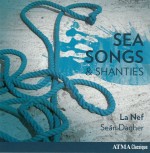 The next disc also comes out of Quebec, but that’s about where any resemblance ends. I first thought that Sea Songs & Shanties (ATMA ACD2 2749) was a departure for La Nef (la-nef.com) but I now realize that in their more-than-two-and-a-half-decade history La Nef has encompassed a wealth of styles from “early music, the music of oral traditions, world music, experimental and contemporary approaches to musical creation.”
The next disc also comes out of Quebec, but that’s about where any resemblance ends. I first thought that Sea Songs & Shanties (ATMA ACD2 2749) was a departure for La Nef (la-nef.com) but I now realize that in their more-than-two-and-a-half-decade history La Nef has encompassed a wealth of styles from “early music, the music of oral traditions, world music, experimental and contemporary approaches to musical creation.”
This current project is under the direction of eclectic singer Seán Dagher, himself as at home in an Irish pub as in many musical traditions from Medieval and Baroque through contemporary folk. Dagher tells us: “These songs did not start out as music to be heard. These were songs to sing, songs to help with the work, songs to pass the time. Their original functions influenced the way they are built […] as call and response songs: a whole crew can learn a song from one man in the first instants he’s singing it. They are sung rhythmically, so the hauling is most efficient. Or they are sung freely, as if to fill the long days and evenings spent together. These songs are spread by oral trading, creating many variants and variations.”
This tradition was brought home to me earlier this summer when I came upon a version of the song I had grown up believing was called Sloop John B. As I found out from Tom Lewis’ rendition of the original Nassau Bound, the Beach Boys “left out the [most interesting] parts.” That, in combination with re-visiting a disc I wrote about last year, by Chaim Tannenbaum, which includes a duet with Loudon Wainwright on the traditional tune Paddy Doyle, primed the pump for my appreciation of this Irish-tinged maritime journey with La Nef.
The disc opens gently with Leave Her, Johnny, with sparse cittern accompaniment that gradually adds more voices, bass and flute and grows to a full finish replete with bosun’s whistle, wave sounds and seagull cries. As the disc progresses through drinking songs and laments, cautionary tales of press gangs and ship wrecks, welcoming tunes like Over the Hills and Far Away and Haul on the Bowline, we are drawn into the myriad moods of the seafarer. It’s at times randy and rugged, so strap yourself to the mast and prepare for adventure. But be forewarned, like shades of the John B: “I hate to sail on this rotten tub; No grog allowed and rotten grub,” so pack a lunch!
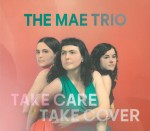 I have written on several occasions in these pages about “my favourite band,” the newgrass-flavoured Joy Kills Sorrow, and lamented their demise. Since they disbanded a couple of years ago I have been on the lookout for a successor to comfort me. Although not as instrumentally virtuosic, over the summer I had the pleasure of hearing a group from Australia that went a long way towards filling that void: The MAE Trio, three young women the initials of whose given names (Maggie, Anita and Elsie) provide the acronym of their trio’s name. When my wife and I saw them at the Burdock, they played violin, mandolin, guitar, banjo and cello between them, and produced some sweet high harmonies on mostly original material. One of the songs, Haul Away, is a quasi-sea shanty, but I don’t think that alone explains my infatuation – I left the gig humming the title track of their latest release Take Care, Take Cover (Creative Victoria Records) and am very glad to have taken a copy home with me.
I have written on several occasions in these pages about “my favourite band,” the newgrass-flavoured Joy Kills Sorrow, and lamented their demise. Since they disbanded a couple of years ago I have been on the lookout for a successor to comfort me. Although not as instrumentally virtuosic, over the summer I had the pleasure of hearing a group from Australia that went a long way towards filling that void: The MAE Trio, three young women the initials of whose given names (Maggie, Anita and Elsie) provide the acronym of their trio’s name. When my wife and I saw them at the Burdock, they played violin, mandolin, guitar, banjo and cello between them, and produced some sweet high harmonies on mostly original material. One of the songs, Haul Away, is a quasi-sea shanty, but I don’t think that alone explains my infatuation – I left the gig humming the title track of their latest release Take Care, Take Cover (Creative Victoria Records) and am very glad to have taken a copy home with me.
Evidently this was their second trip to Canada (and second Burdock appearance) and although it may be a while before they return – throughout September and October these world travellers have shows in Ireland and various places in the UK – you can sample material, and buy the CD, on their website (themaetrio.com).
We welcome your feedback and invite submissions. CDs and comments should be sent to: DISCoveries, WholeNote Media Inc., The Centre for Social Innovation, 503 – 720 Bathurst St. Toronto ON M5S 2R4. We also encourage you to visit our website thewholenote.com, where you can find enhanced reviews in the Listening Room with audio samples, upcoming performance details and direct links to performers, composers and record labels.
David Olds, DISCoveries Editor
discoveries@thewholenote.com



